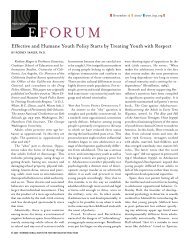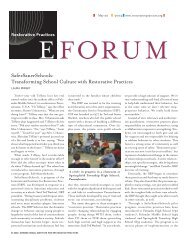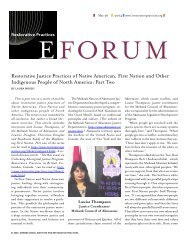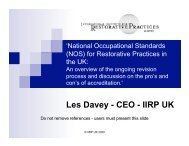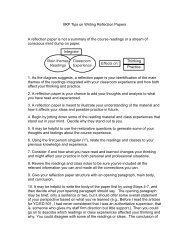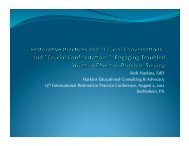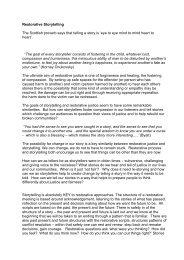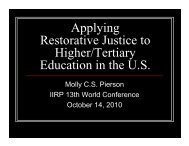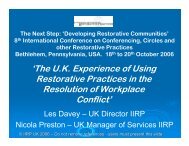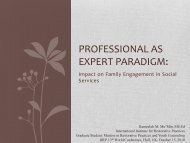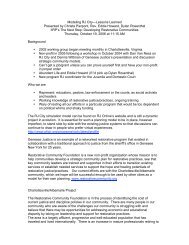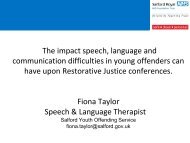Between Wholeness and Restoration - IIRP
Between Wholeness and Restoration - IIRP
Between Wholeness and Restoration - IIRP
Create successful ePaper yourself
Turn your PDF publications into a flip-book with our unique Google optimized e-Paper software.
perception of pessimism Because, if rejected, I would feel less than whole, less than<br />
worthy. It would be easier to remain silent or better yet, hide by echoing the voices of<br />
others I admired. hooks (2003) shakes me from my hesitancy when she says, “This fear<br />
of being found personally wanting in some way is often one of the greatest barriers to<br />
promoting critical consciousness” (p. 107) <strong>and</strong> I reread reflections I have written in an<br />
earlier course regarding this culture of fear.<br />
Our culture is bent on preserving a wholeness that doesn’t exist.<br />
We blindly welcome advertising that claims we can have a perfect<br />
body, our cars can enhance our image, we can take a pill to loose<br />
unwanted fat or be rid of headaches. We are told the future is in our<br />
h<strong>and</strong>s, we can have freedom at age 55, beer can make us the life of the<br />
party … all such messages deceptively try to convince us that there is<br />
a better world that others live in <strong>and</strong> we should aspire to be part of it.<br />
Ironically, if we could individually stop <strong>and</strong> accept our inability to be<br />
whole <strong>and</strong> then collectively admit that we have messed up the world<br />
we live in, we may discover wholeness.<br />
What impact might such an admission of brokenness have on<br />
education As a teacher in a classroom of eight-year-old children<br />
admitting my shortcomings <strong>and</strong> acknowledging theirs as normal, could<br />
result in the walls of defensiveness tumbling down. The tendency to<br />
frantically convey an image of wholeness as a teacher or student is no<br />
longer necessary. The power of competitiveness would be disarmed<br />
for all would be valued equally. The tightly clenched fists holding on<br />
to scraps of identity would slowly be released. A space will have been<br />
created in which the sacred could be revealed <strong>and</strong> the voice of<br />
acceptance <strong>and</strong> love heard. Within this space, all inhabitants could<br />
experience “being with” each other <strong>and</strong> the subject at h<strong>and</strong>.<br />
I share these thoughts to provide a description of the setting in which restorative<br />
practice in particular finds itself <strong>and</strong> to give a personal account of how such a setting<br />
continues to impact my current efforts. I continue now by considering more closely the<br />
divide of brokenness in which I believe we all st<strong>and</strong> <strong>and</strong> how restorative practice helps to<br />
deal with the tension between what is <strong>and</strong> what could be.<br />
<strong>Wholeness</strong> Brokenness <strong>Restoration</strong>



